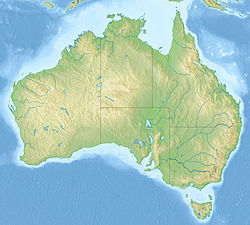The Anglo-Australian Telescope (AAT) is a 3.9m equatorially mounted telescope operated by the Anglo-Australian Observatory and situated at the Siding Spring Observatory, Australia at an altitude of a little over 1100m. It is jointly funded by the United Kingdom and Australia, with observing time made available to astronomers worldwide. It is equipped with a number of instruments, including the Two Degree Field facility (2dF), a robotic optical fiber positioner for obtaining spectroscopy of up to 400 objects simultaneously; the University College London Échelle Spectrograph (UCLES), a high-resolution optical spectrograph which has been used to discover many extrasolar planets; and IRIS2, a wide-field infrared camera and spectrograph.
| File:Aat telescope.jpg | |
| Location(s) | New South Wales, AUS |
|---|---|
| Coordinates | 31°16′31″S 149°04′01″E / 31.2754°S 149.067°E |
| Organization | Anglo-Australian Observatory |
| Altitude | 1,100 m (3,600 ft) |
| Wavelength | optical, IR |
| Built | 1974 |
| Telescope style | prime/Cassegrain/coudé |
| Diameter | 3.9m, 12.8ft |
| Collecting area | 12m², 129ft² |
| Focal length | 12.7m, 42.7ft |
| Mounting | equatorial |
| Enclosure | spherical |
| Website | http://www.aao.gov.au/about/aat.html |
| | |
The telescope was commissioned in 1974 with a view to allowing high quality observations of the sky from the southern hemisphere, as in the 1970s most major telescopes were located in the north.
The AAT was one of the last large telescopes built with an equatorial mount. More recent large telescopes have instead adopted the more compact and mechanically stable altazimuth mount. The AAT was however one of the very first telescopes to be fully computer-controlled, and set new standards for pointing and tracking accuracy.
